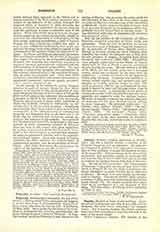

Fabricius, HIERONYMUS (surnamed AB AQUAPENDENTE), a distinguished Italian anatomist and surgeon, b. in the little town of Acquapendente (Aquae-Taurinae), twelve miles from Orvieto, in 1537; d. at Padua, May 21, 1619. He is known by the name of his birthplace to distinguish him from his contemporary, the great German surgeon, Fabricius Hildanus. In English medical literature Fabricius is best known as the teacher of Harvey, who gives him the entire credit for the discovery of the valves in the veins which meant so much for Harvey’s own discovery of the circulation of the blood. Some valves in the veins, however, had been seen and described by investigators before this, probably even by Erasistratus in ancient times. It was Fabricius’ merit that he recognized the existence of a system of valves.
Sent by his parents to the University of Padua, Fabricius succeeded admirably in Greek, Latin, and philosophy. When he took up medicine he became the favorite pupil of Fallopius, being his demonstrator in anatomy at Padua when scarcely twenty.
Though he was only twenty-five when Fallopius died, Fabricius was chosen his successor and a little later became professor of surgery, occupying both chairs for nearly half a century (1562-1609). His abilities were properly appreciated by the Senate of Venice, which built for him at Padua a spacious anatomical theatre bearing his name. He was created a Knight of St. Mark, and his annual salary was a thousand crowns, which was continued for ten years after his resignation. A statue was erected to his memory in Padua after his death. Fabricius was indifferent to money, refused regular fees, and accepted only such presents as wealthy patients forced on him. His work on anatomy (500 fol. pp.) is illustrated by hundreds of figures on sixty-one full-page plates, some of the best ever made. A monograph on the speech of brutes and a study of the comparative anatomy of the appendix are suggestive even for modern readers. His work on surgery is scarcely less valuable than that on anatomy and has gone through twenty editions in many languages. His principal works are: “De visione, voce, auditu” (Venice, 1600); “De brutorum loquelae” (Padua, 1603); “De formato fetu” (Venice, 1600); “De locutione” (Venice, 1627); “Tractatus anatomicus triplex” (Frankfort, 1614). All his other works were reprinted at Frankfort shortly after this time, and all his works at Leipzig in 1687.
JAMES J. WALSH

